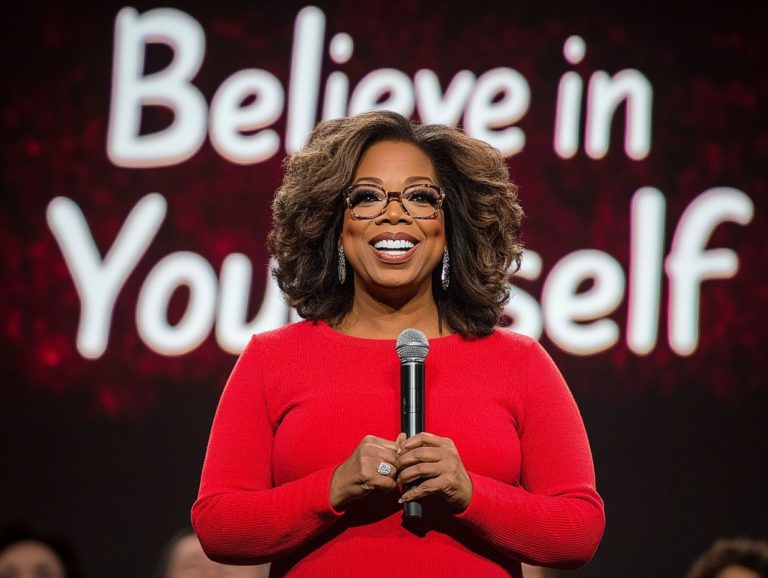5 Outstanding Women in Science and Their Stories
Throughout history, women have made remarkable contributions to science, often surmounting significant barriers in their pursuit of knowledge and innovation.
This piece shines a light on five extraordinary women Marie Curie, Ada Lovelace, Rosalind Franklin, Jane Goodall, and Mae Jemison who defied gender norms and transformed the landscape of their respective fields.
Explore the challenges they faced and their groundbreaking achievements. Join in the celebration of these trailblazers and consider how to inspire future generations of women in science.
Contents
- Key Takeaways:
- 1. Marie Curie: A Nobel Pioneer
- 2. Ada Lovelace: The First Computer Programmer
- 3. Rosalind Franklin: The Pioneer of DNA Research
- 4. Jane Goodall: The Primatologist Who Changed Our Understanding of Chimpanzees
- 5. Mae Jemison: The First African-American Woman in Space
- What Challenges Did These Women Face in Their Careers?
- Frequently Asked Questions
- Who are the 5 Outstanding Women in Science and what are their stories?
- What are some notable achievements of Marie Curie?
- What is Rosalind Franklin’s contribution to science?
- How did Jane Goodall make an impact in the field of primatology?
- Why is Ada Lovelace considered the world’s first computer programmer?
- What was Katherine Johnson’s role in the NASA space program?
Key Takeaways:

- These five women shattered barriers in science, proving that gender doesn’t limit potential.
- Each made significant contributions to their fields, paving the way for future generations of female scientists.
- Their stories serve as inspiration, reminding us that determination and perseverance lead to great achievements, regardless of societal expectations.
1. Marie Curie: A Nobel Pioneer
Marie Curie is a remarkable figure in physics and chemistry. Her groundbreaking contributions changed the landscape of science forever.
She became the first woman to win a Nobel Prize in 1903, solidifying her legacy as a trailblazer in radioactivity, which is the release of energy from unstable atoms.
Her relentless quest for knowledge revolutionized our understanding of atomic structure. This passion sparked interest in countless women, encouraging those underrepresented in science to forge their own paths in STEM.
Curie’s unwavering dedication to her research led to amazing discoveries, including radium and polonium. These innovations paved the way for advancements in medicine and radiation therapy.
Her journey illuminated the way for aspiring female scientists, urging them to break through barriers in a male-dominated field.
Her legacy is a compelling testament to the significance of diversity in science. Progress thrives when voices from all backgrounds are acknowledged and valued.
The resilience Curie exhibited advanced scientific understanding and transformed perceptions, creating an environment where future generations of women can confidently contribute to the ever-evolving landscape of STEM.
2. Ada Lovelace: The First Computer Programmer
Ada Lovelace was the first computer programmer. Her groundbreaking work laid the foundation for modern computing and highlighted the crucial role women played in the evolution of technology and science.
When collaborating with Charles Babbage on the Analytical Engine, Lovelace demonstrated a remarkable ability to envision more than simple calculations. She grasped the potential for algorithms to navigate complex ideas.
Her notes on the engine included what is now recognized as the first algorithm intended for implementation. This marked a significant leap in our understanding of automated computation.
By moving beyond the confines of simple calculations, she shaped the future of programming and inspired countless women to pursue careers in technology and science. Her work paved the way for female innovators in fields that were once the exclusive domain of men.
3. Rosalind Franklin: The Pioneer of DNA Research
Rosalind Franklin’s pioneering work in X-ray crystallography was revolutionary, playing a crucial role in unraveling the structure of DNA. This landmark achievement advanced our understanding of genetics and underscored the vital contributions of women in scientific research.
Through her meticulous studies, she captured essential photographs, particularly the famous Photo 51, which unveiled the helical structure of DNA. Yet, despite her groundbreaking contributions, Franklin faced many challenges as a woman in a predominantly male field, often going unrecognized during her lifetime.
These obstacles, from gender bias to restricted access to research resources, could have impeded her progress. However, today, her legacy is celebrated, showcasing her scientific brilliance and how her determination paved the way for future generations of women in science.
As the story of DNA’s discovery unfolds, it rightfully honors her contributions, affirming that her work laid the foundational blueprint of life itself.
4. Jane Goodall: The Primatologist Who Changed Our Understanding of Chimpanzees

Jane Goodall’s field studies transformed our understanding of chimpanzee behavior and intelligence. She established herself as a groundbreaking figure in science and a leading advocate for conservation and animal welfare.
Her incredible observation techniques, involving long hours spent close to these remarkable primates, revealed astonishing insights into their social relationships, tool use, and emotional depth. This immersive approach not only unveils the complexity of their lives but blurs the lines between human and animal behavior, challenging preconceived notions about intelligence and emotion in non-human species.
The implications of her research extend well beyond academia, significantly influencing global conservation strategies and raising awareness about the need to protect these incredible creatures and their habitats.
Goodall’s success inspires countless women, encouraging them to pursue careers in science. She demonstrates that dedication can lead to groundbreaking contributions in any field.
5. Mae Jemison: The First African-American Woman in Space
Mae Jemison made history as the first African-American woman in space, leading the charge for diversity in STEM fields and highlighting the critical importance of representation in the sciences.
Her journey from a childhood fascination with the stars to rigorous education in medicine and engineering reveals how relentless curiosity and determination can forge a remarkable path.
She transformed the landscape for women of color in scientific disciplines, showing that passion combined with hard work can dismantle racial and gender barriers.
Beyond her iconic spaceflight, her contributions to various scientific fields spanning health, technology, and education position her as an inspiring figure for the next generation of underrepresented women eager to enter STEM careers.
By sharing her journey, she enables countless individuals to dream big and pursue their passions without limitations.
What Challenges Did These Women Face in Their Careers?
Throughout history, pioneering female scientists like Marie Curie, Rosalind Franklin, and Jane Goodall faced many challenges in their careers challenges rooted in societal gender discrimination, a lack of recognition, and an environment where women were often sidelined in the scientific community, hampering their chances for advancement.
These remarkable women not only fought against stereotypes that questioned their capabilities but also navigated rules and systems that held women back, which frequently denied them access to education and vital funding. As they pursued their research, they often encountered settings that were unwelcoming or even hostile, mirroring broader societal norms that undervalued the contributions of women.
The implications of these persistent obstacles are profound, as they discourage young women from pursuing careers in STEM fields and perpetuate a cycle of underrepresentation. Highlighting these challenges shows that the fight for equality in science is a societal issue that calls for collective attention and action.
How Did These Women Overcome Gender Discrimination in the Scientific Field?
Women like Marie Curie and Rosalind Franklin overcame gender discrimination in the scientific realm through sheer perseverance, groundbreaking discoveries, and an unwavering commitment to their work. Their remarkable achievements not only advanced science but also challenged entrenched societal stereotypes.
Their stories show how important mentorship is; they actively sought guidance from established scientists while generously offering support to younger female colleagues. Advocacy emerged as a powerful tool in their arsenal, as they called attention to the need for policy changes within institutions to cultivate a more inclusive environment.
Their resilience didn t just propel their own careers; it ignited a movement that heightened awareness of the barriers faced by female scientists. The struggles these women endured laid the groundwork for future generations, ultimately leading to enhanced recognition and opportunities for women in science and fostering a significant cultural shift within the scientific community.
What Are the Contributions of These Women to Their Respective Fields?

The contributions of women like Ada Lovelace, Marie Curie, and Katherine Johnson to their fields are nothing short of monumental. They ve shattered barriers and set new standards for excellence in science and technology.
Meet Lovelace, the trailblazer often hailed as the first computer programmer! She laid the very groundwork for modern computing concepts, inspiring countless programmers and software engineers who followed her lead.
Then there s Curie, whose pioneering research in radioactivity didn t just earn her two Nobel Prizes but also paved crucial pathways in medical physics and cancer treatment. Radioactivity is the process by which unstable atomic nuclei lose energy by emitting radiation, a key area in medical treatments, significantly impacting today s health sciences.
And let s not forget Johnson, whose remarkable work as a mathematician at NASA was critical to the success of the U.S. space program. Her achievements highlight the essential role women play in STEM fields, encouraging a new generation to pursue careers once deemed out of reach.
Together, the groundbreaking accomplishments of these women serve as a beacon of inspiration, illuminating the undeniable impact women have in shaping the future of science.
What Impact Have These Women Made on Society?
The impact of female scientists like Jane Goodall and Mae Jemison extends far beyond their impressive accomplishments; it resonates deeply, inspiring societal change and motivating more women like you to pursue careers in STEM fields.
Their groundbreaking work has transformed public perception, challenging outdated stereotypes that once limited women’s roles. By actively dismantling barriers, these pioneers have not only advanced their respective fields but also paved the way for a richer, more inclusive conversation about gender equality in science.
Educational institutions are now recognizing the significance of diverse role models and are fostering environments that support and uplift aspiring female scientists. As a result, you can see a new generation inspired to dive into scientific exploration, contributing to a more equitable landscape that truly values innovation and diverse perspectives.
What Can We Learn from These Women in Science?
The stories of pioneering female scientists offer profound lessons in perseverance, the necessity of representation in science, and the essential support needed for women in STEM to cultivate future generations of innovators.
Their journeys illuminate the unwavering spirit required to surmount obstacles. Adversity can transform individuals into powerful advocates for equality and collaboration. These trailblazers not only carved paths for themselves but also embraced the role of mentors, inspiring countless young women to chase their dreams in scientific fields.
By drawing from these rich experiences, current initiatives can emphasize mentorship programs and community support. This creates an environment where emerging female scientists feel valued and enabled to realize their full potential. Upholding these foundational principles will ensure that the legacy of resilience continues to uplift and guide future innovators.
How Can We Encourage More Women to Pursue Careers in Science?
Encouraging more women to pursue careers in science requires a mix of strategies that bring together education, mentorship programs, and societal support. This creates an inclusive environment that truly celebrates female scientists and their invaluable contributions.
Implementing community outreach initiatives can spark interest among young girls. These initiatives introduce them to STEM fields through engaging workshops and hands-on activities. Educational reforms are equally crucial; curricula should highlight female role models and their achievements, making science relatable and accessible to all.
Media representation is key; showcasing stories of women excelling in STEM serves as a powerful source of inspiration and motivation for the next generation.
Establishing strong mentorship and support networks is essential in fostering female talent. This provides the guidance and encouragement needed as they navigate their careers in scientific disciplines. Collaborating with organizations dedicated to advancing women’s roles in these fields can amplify their voices and drive lasting change.
A video highlighting the achievements of women in science.
Frequently Asked Questions

Who are the 5 Outstanding Women in Science and what are their stories?
The 5 Outstanding Women in Science are Marie Curie, Rosalind Franklin, Jane Goodall, Ada Lovelace, and Katherine Johnson. Each of these women made significant contributions to their respective fields of science, despite facing many challenges and obstacles.
What are some notable achievements of Marie Curie?
Marie Curie was a physicist and chemist best known for her pioneering research on radioactivity. She was the first woman to win a Nobel Prize and the first person to win it twice in different fields: physics and chemistry.
What is Rosalind Franklin’s contribution to science?
Rosalind Franklin was a chemist and a specialist in X-ray crystallography. Her work was crucial in discovering the structure of DNA. Her famous “Photo 51” image provided evidence for the double helix structure of DNA, but she did not receive credit for her contribution until after her death.
How did Jane Goodall make an impact in the field of primatology?
Jane Goodall is a British primatologist and anthropologist best known for her groundbreaking research on chimpanzees. She was the first person to observe chimpanzees making and using tools, challenging the idea that tool-making was a unique trait of humans.
Why is Ada Lovelace considered the world’s first computer programmer?
Ada Lovelace, also known as the “Enchantress of Numbers,” was a mathematician and writer credited as the first computer programmer. She wrote the first algorithm specifically designed to be carried out by a machine, making her a pioneer in the field of computer science.
What was Katherine Johnson’s role in the NASA space program?
Katherine Johnson was a mathematician and space scientist who played a crucial role in the early years of NASA’s space program. She calculated the trajectories for many of the agency’s early missions, including the Apollo 11 mission that landed the first humans on the moon.
To learn more about these remarkable women and their contributions to science, consider exploring further resources or getting involved in mentorship programs that support women in STEM.





